Grandparents beware…
March 31, 2011
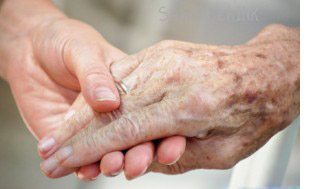 One of the best things about technology is the way it can keep families connected. But in recent weeks, consumer agencies have issued a warning:
One of the best things about technology is the way it can keep families connected. But in recent weeks, consumer agencies have issued a warning:
Grandparents beware.
A longstanding wire fraud scam has been taking a national toll on loving relatives, particularly seniors, to the point that authorities in recent week have decided to make an all-out assault on it.
“It’s become a big issue,” says Rigo Reyes, acting director of the Los Angeles County Department of Consumer Affairs. “Last year, the Federal Trade Commission got over 60,000 complaints on it.”
Here’s how it works:
A senior citizen gets an urgent call, email or Facebook message from someone claiming to be a police officer or an adolescent grandchild. The message says the grandchild has been hurt or arrested or is otherwise in trouble, and needs hundreds or thousands of dollars to be wired immediately via money order or Western Union. And one more thing: Don’t tell mom and dad.
“The grandparents don’t want anyone to be in trouble, so they wire the money without checking first with other family members,” says Reyes. “In one case, the grandmother told the caller, ‘You don’t sound like my grandson,’ and the guy said ‘I broke my nose in a car accident, so I sound different’.
“But in many cases, the crooks can fool you because they hack into Facebook accounts and get enough information about the family to drop names and birth dates and so forth. They get marketing lists with specific details, names and addresses.
“They can be convincing, but once that money is wired, it can be picked up by anyone with a password — and good luck getting it back.”
The Department of Consumer Affairs and the Consumer Federation of America offer these suggestions for seniors to avoid being scammed:
–Always check with other family members if you get an SOS from a family member.
–Be proactive. Create a family code word to signal emergencies to each other
–Never wire money without being absolutely sure of the recipient and the reason.
And this goes for you, too, Mom and Dad.
Posted 3/31/11
Trailblazer makes his mark in Calabasas
March 31, 2011
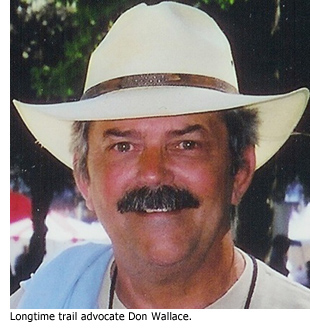 March was a banner month for Don Wallace. And not just because he and his wife, Jeanne, celebrated their 50th wedding anniversary.
March was a banner month for Don Wallace. And not just because he and his wife, Jeanne, celebrated their 50th wedding anniversary.
“We finished the party,” Wallace remembers, “and the very next afternoon, the phone rang.” With friends and family still filtering in and out of the Wallaces’ 4.5-acre ranchette in the Santa Monica Mountains, the longtime trail advocate let out a whoop as he received news for which he had waited most of his 70-year lifetime:
His beloved Las Virgenes Creek Trail had finally found its way under the Ventura Freeway.
“I was ecstatic,” Wallace says, still thrilled at the approval earlier this month of $300,000 in excess county bond funds that will allow the trail to run uninterrupted from the Santa Monica Mountains down through underpasses at the 101 and Agoura Road in Calabasas and on into Malibu Creek State Park.
The trail easement and improvements—officially dubbed “The Don Wallace Trail Project”—will not only connect the Santa Monica Mountains to the beach for people, horses and wildlife, but also honor one of the most zealous and hardworking trail advocates in Southern California.
For decades, Wallace and other activists have sought to create a path that would allow people and animals to follow Las Virgenes Creek from the pristine mountains down to the ocean, but their dream was stymied by development and traffic. Even as crucial tracts were acquired for the public, the 101 Freeway remained a dangerous concrete barrier between the mountain part of the trail and the beach part.
Then, last year, with funding allocated by Supervisor Zev Yaroslavsky, the Mountains Recreation and Conservation Authority bought a key swath of wilderness known as Firehouse Hill from the developer Fred Sands. The nearly 200-acre Calabasas property is a gateway to the Santa Monica Mountains National Recreation Area—and sits right next to the freeway.
Though environmentalists, activists and government officials cheered the acquisition for many reasons, trail advocates immediately saw its potential as an avenue through which they could bring the Las Virgenes Creek Trail—which is part of a larger loop called the Calabasas Cold Creek Trail—down to and under the 101 along a flood control easement, where it could then connect to the Malibu Creek State Park trail system. They’d just need to make the underpass safe and accessible.
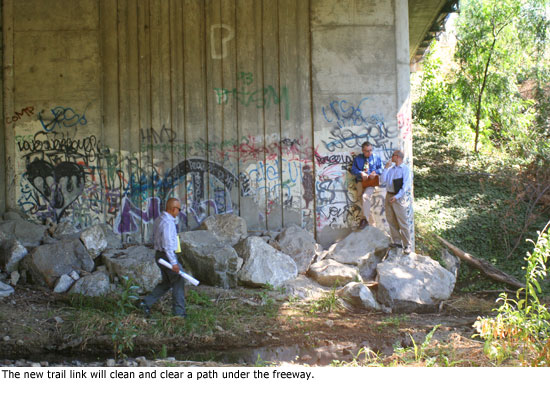
The March vote provided that crucial support, opening the way for a 2,500-foot link that is expected to break ground next year.
“This is a wonderful victory,” said Wallace, crediting the many public agencies that pushed for the project. But Wallace’s friends and fellow advocates say there’s a reason the key link is being named after him.
“He’s one of the hardest working gentlemen I know,” says Stephanie Abronson, who edits the newsletter for Equestrian Trails Inc., Corral 36, a mountain equestrian group.
Born in Tennessee , Wallace moved to Van Nuys as a teenager after his father, a restaurant owner, visited relatives here and made it a goal to move to California . At 20, he married Jeanne, whom he’d met in a chemistry lab at Pierce College .
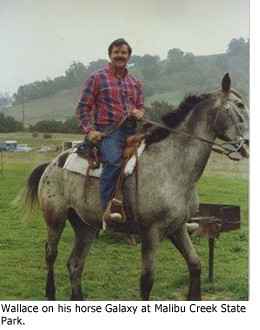 The couple settled in Canoga Park , had two sons and got into horseback riding, eventually deciding that they wanted enough land to have their own corral. Wallace, by now a Los Angeles city firefighter, found a spread near the unincorporated community of Monte Nido, and the couple built a house on it. They still live there with assorted horses, cats and dogs and a potbellied pig.
The couple settled in Canoga Park , had two sons and got into horseback riding, eventually deciding that they wanted enough land to have their own corral. Wallace, by now a Los Angeles city firefighter, found a spread near the unincorporated community of Monte Nido, and the couple built a house on it. They still live there with assorted horses, cats and dogs and a potbellied pig.
A trail ran near the Wallace’s acreage, and one day in the early 1970s, he says, a neighbor who wanted to build a winery came out with a bulldozer and blocked it in an attempt to keep passersby away.
“That trail had been put in in 1935 by the Boy Scouts,” says Wallace, who eventually forced the neighbor to open an alternative easement.
“It took three years of work and masses of paper, but I learned never to give up and never to say that it can’t be done.”
Since then, Wallace has served on the Santa Monica National Recreation Area Advisory Commission, the Resources Conservation District of the Santa Monica Mountains, the Malibu Creek Watershed Council and many other groups seeking to improve the mountains community.
He also served as a deputy for then-Supervisor Edmund D. Edelman in the early 1990s, and ran for supervisor himself in 1988 and 1994.
Throughout, when he wasn’t lobbying for trails or riding his horses on them, he was out clearing them with his bare hands, says Ruth Gerson, president of the Santa Monica Mountains Trail Council—“repairing tread, cutting back brush, reducing erosion, and encouraging others to work with him.”
That commitment has been challenged in recent years by health problems. Wallace says he has faced a stroke, vascular surgery and two bouts of prostate cancer since the 1990s; last year he underwent a triple bypass.
But his projects are far from finished—he’s already wondering how to restore the old Boy Scout trail behind his house.
“I walk every day,” says the trail blazer. “And I’m a very strong guy for 70.”
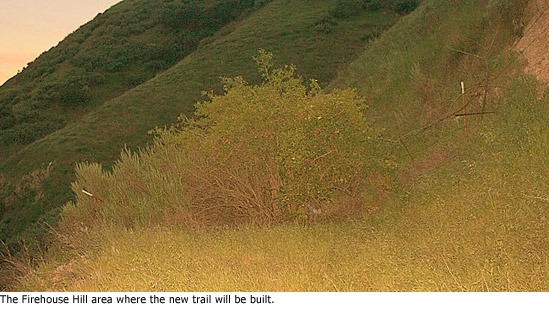
Posted 3/31/11
Capturing native plants on paper
March 24, 2011
Tucked away just northwest of downtown Los Angeles in the shadows of the Harbor and Hollywood Freeways, Vista Hermosa Natural Park is a welcome patch of green in a vast concrete cityscape.
This Sunday, March 27, at 2:00 pm, join a volunteer docent for a stroll through Vista Hermosa’s gardens, followed by a special drawing session that calls upon your inner naturalist to capture the floral beauty and put to paper images of the native plant species.
It’s all courtesy of our two regional state park agencies—the Santa Monica Mountains Conservancy and the Mountains Recreation Conservation Authority, which together help acquire and maintain thousands of acres of precious urban wilderness areas in and around the Los Angeles region.
Vista Hermosa Park is located at 100 N. Toluca Street in Los Angeles. Participants should meet at the Grotto Amphitheatre for the two-hour adventure.
Here’s Vista Hermosa Park’s online information, or call (213) 250-1100.
Posted 3/24/11
A Marine’s tale unfolds at the Hammer
March 24, 2011
Marine Corps Master Sgt. Jerry Ensminger served his country faithfully for nearly 25 years, toughening up thousands of enlistees as their drill instructor. But then his nine-year-old contracted a rare form of leukemia which eventually took her life. Engulfed by grief, but determined to seek out the truth, he eventually stumbled upon a cover-up of a massive water-pollution accident and set about trying to expose it.
UCLA’s Hammer Museum Work in Progress series, in conjunction with the Sundance Institute, tonight will screen the documentary of his story, “Semper Fi: Always Faithful,” tonight, March 24, 2011 at 8:00 pm, followed by a Q&A with filmmakers Rachel Libert and Tony Hardmon.
Hammer programs are free to the public, but you’ll still need tickets—available on a first-come, first-served basis at the Billy Wilder Theater Box Office an hour in advance of showtime. Hammer members get preferred seating, depending on availability. No advance reservations or RSVPs needed.
The Hammer Museum is located at 10899 Wilshire Blvd, on the northeast corner of Westwood and Wilshire Boulevards in Westwood Village, 3 blocks east of the 405 freeway’s Wilshire Boulevard exit. Park underneath after 6p for only $3. Here’s everything you need to know to visit the Hammer, or call (310) 443-7000.
Posted 3/24/11
Happy 100th, Tennessee
March 24, 2011
Marlon Brando’s Stanley Kowalski, howling in the night for his indifferent Stella. Vivien Leigh’s Blanche DuBois, depending on “the kindness of strangers” as she slips into madness. Elizabeth Taylor’s Maggie, feral and frustrated, restless as a “cat on a hot tin roof.”
These are just a few of American literature’s most indelible characters as conjured up by playwright Tennessee Williams, who would have turned 100 this Saturday, March 26. Fittingly, Hollywood’s Fountain Theatre will celebrate the birthday centennial for Williams—who died in 1981 at the age of 70—with the West Coast premiere production of Williams’ final play, ”A House Not Meant to Stand.”
Honoring the playwright’s roots as a son of Mississippi, the Fountain will be serving up some Southern hospitality along with birthday cake and mint juleps. A video montage will touch on the highlights of Williams’ fertile creative life; audience members are invited to dress the part of their favorite characters.
For showtimes, directions and ticket information, visit the Fountain Theatre online at www.FountainTheatre.com, or call (323) 663-1525 for further information.
Posted 3/24/11
Expo Line picks up speed
March 24, 2011
As the first “road tests” begin on the initial phase of the new Exposition light rail project, a series of recent decisions is blazing the trail toward the line’s ultimate finish in Santa Monica.
A partial opening of the Expo Line from downtown Los Angeles to La Cienega is planned for this fall, with the conclusion of Phase 1 to Culver City expected next year. Meanwhile, work is beginning in earnest on Expo Phase 2, which will extend the line to Colorado and 4th Street in Santa Monica by 2015. (This interactive map shows the entire 15.2 mile route.)
Expo’s Board of Directors on March 18 voted to award the Phase 2 design-build contract to the firm Skanska/Rados. The board also voted to build an aerial crossing and station at Sepulveda instead of a street-level crossing, which was opposed by some neighborhood groups.
“Sepulveda is the major north-south thoroughfare on the Westside. Putting an at-grade crossing there is almost like putting an at-grade crossing on the 405 Freeway,” said Chuck Ray, co-chair of the Mar Vista Community Council’s Transportation and Infrastructure Committee, which backed the aerial option.
The elevated crossing and station will cost nearly $5.3 million more than the street level version. But the city of Los Angeles is picking up the tab for the additional cost, using money from the West L.A. traffic mitigation fund. (The motion by Councilmembers Paul Koretz and Bill Rosendahl is here.) The Phase 2 overall budget is $1.5 billion.
“This is an enhancement to the project. It will be a benefit to the project, to the city and to the Westside,” said Samantha Bricker, Chief Operating Officer for the Expo Line Construction Authority.
The Expo Board also voted in favor of the “no-parking” option at the Expo Line’s Westwood station. This option was preferred by some in the community, who feared that a proposed 170-space parking lot would draw too much additional traffic to their neighborhood.
“Putting a parking lot in the middle of our residential neighborhood is asking too much,” said Sarah Hays, co-chair of the group Light Rail for Cheviot.
Expo officials will be soliciting more public input for the Phase 2 design-build process at a series of community meetings in early May. (The dates will be announced soon.)
Meanwhile, the line’s Phase 1 progress was visible around USC earlier this week when a mock-up of a future Expo Line train (actually a flatbed pushed by something called a speed swing) took a ride on the tracks to make sure everything lines up properly with the station platforms.
Posted 3/24/11
Wave of tsunami prep heads our way
March 24, 2011
Add this to the list of potential catastrophes that come with living in Southern California: an earthquake-triggered tsunami washing over beaches and harbors and leaving devastation all along the coast.
The nightmarish images of powerful waves buffeting Japan after the March 11 quake there have prompted many to wonder whether the same thing could happen here—and how to escape it if it does. But some Los Angeles experts and planners have been focused on the local tsunami threat long before the first wave hit Japan.
And their assessment of what could be coming our way, and how best to prepare for it, is both simple and complex.
Costas Synolakis, who directs the Tsunami Research Center at USC, said tsunamis triggered by faraway events occur once or more a decade here, and generally pose a relatively minor threat to human safety in Southern California—although they can wreak havoc in the ports by damaging docks and disrupting shipping. A tsunami triggered by a large earthquake in Chile last year did just that, he said—though since it was a Saturday, its impact was less severe than it might have been.
However, a major temblor in the Aleutian earthquake zone in Alaska could pose a significant exception to the general rule about distant-source tsunamis. Such a quake could unleash a powerful tsunami that could endanger both people and property in low-lying coastal communities such as Marina del Rey, Venice and Long Beach, Synolakis said.
To better understand the possible impact of a hypothetical 8.8 quake in the Eastern Aleutian Islands, officials with the U.S. Geological Survey started work in January on their first-ever emergency planning “tsunami scenario” for Southern California. Modeled on the Great California ShakeOut, the scenario, when completed in 2013, will assess how such a tsunami would affect the region economically, environmentally and as an emergency response challenge. It also could serve as the basis for future tsunami response exercises.
Whether they end up causing minor or major damage, tsunamis that originate far away come equipped with one important safety feature: forecasters can see them coming, often hours in advance, allowing time to alert the public and evacuate beach areas likely to be affected.
A “local-source” tsunami would not be so kind. A tsunami triggered by a nearby offshore earthquake could trigger an underwater landslide, causing profound and fast-moving damage all along the Santa Monica Bay—with little or no time for evacuations.
“The landslide event keeps me up more at night because it’s far less predictable,” Synolakis said.
On the upside: it’s an exceptionally rare occurrence, taking place once every 2,000 to 3,000 years, he said.
The Board of Supervisors voted to designate this week “Tsunami Awareness and Preparedness Week” in Los Angeles County, part of a national effort that includes videos like this one.
Planning for any kind of tsunami in Los Angeles County is complicated because there’s no way of knowing in advance which kind will strike.
However, here are some guidelines to improve your odds of staying safe and dry.
Know where you are:
Tsunami “inundation zones” are located all along the coast. Check out this map for a more detailed look at the terrain in various communities. In Marina del Rey, recently-posted signs designate entry and exit points for the tsunami zone, and also point out evacuation routes. “We were fortunate to get one grant to do one [sign] demonstration. We wanted to show it could be done. We just finished it in March,” said Jeff Terry, program manager for the L.A. County Office of Emergency Management.
Make friends with your local emergency services coordinator
With fourteen incorporated cities along the coast, evacuation routes and response plans can vary. In unincorporated Marina del Rey, the latest evacuation map is here.
When the earth moves, get away from the water:
“For most of L.A. County, it’s simply a matter of moving away from the beach,” said Keith Harrison, assistant administrator of the county’s Office of Emergency Management. Resist the temptation to stick around and watch the action; these aren’t ordinary waves.
Don’t expect a siren:
The best source of emergency information will be on radio, TV or online. Los Angeles County emergency response officials said it would be impractical and too expensive to install and maintain enough sirens along the coast to serve as an effective warning system. In addition, the county’s “reverse 911” system, known as Alert L.A., allows authorities to rapidly telephone every land line in the county with emergency information. To be even better plugged in, you can…
Register your cell phone number and e-mail address with Alert L.A.:
Land lines already are covered but take a few minutes to sign up to make sure that official emergency information reaches you wherever you are.
Sometimes the best way out is on foot:
In the event of a fast-approaching local-source tsunami, people in the tsunami zone may have only 5 to 20 minutes to get to higher ground. “Most places you walk up a couple blocks and you’re safe,” Terry said. Added Harrison: “On foot is what we recommend. Don’t get in a car.” For people in a high-rise building, the best response to an extremely fast-moving tsunami could be to climb to a higher floor. (But If there’s time to evacuate, leaving the building and setting out for higher ground would be the safer course.)
The county’s overall tsunami plan was approved in 2006. It’s a good start, but there is still more to do, Harrison said. “One of our goals is to eventually qualify for the “tsunami-ready” designation by NOAA,” he said, referring to the program administered by the National Oceanic and Atmospheric Administration.
Individual county departments have their own plans, and already are working to incorporate insights gained from the recent events in Japan.
“When you look at the video of Japan, it’s apocalyptic. It’s almost surreal, like a movie shoot. It does definitely hit home,” said Santos H. Kreimann, director of the county’s Beaches and Harbors department. “It’s consciousness-raising.”
His department used its new Twitter account to send out messages about the tsunami advisory issued for the Los Angeles coast following the quake in Japan. And it’s been busy ever since with logistical questions such as how best to communicate with and evacuate “live-aboards” who reside on boats in the marina, and figuring out how to relocate the department’s earth-moving equipment far enough from the coast so it will be safe and available for cleanup work after the crisis is over.
“The Japanese event required us to really look at this closer and try to get things done sooner rather than later,” Kreimann said.
Posted 3/2211
County rescuers back in town—for now
March 24, 2011
You could call them the masters of disaster.
But even with an internationally-acclaimed skill set and more frequent flier miles than you can shake a boarding pass at, Los Angeles County’s urban search and rescue team has never before had a run—or a wake-up call—quite like this one.
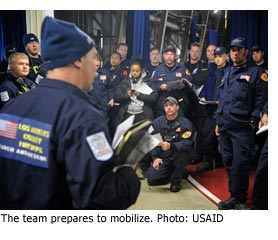 No sooner had they returned from their post-earthquake work in Christchurch, New Zealand than they were summoned to Japan less than 36 hours later to help with the aftermath of the deadly quake and tsunami there.
No sooner had they returned from their post-earthquake work in Christchurch, New Zealand than they were summoned to Japan less than 36 hours later to help with the aftermath of the deadly quake and tsunami there.
“That is a first for us as a team,” said Battalion Chief Tom Ewald, who between disaster assignments heads up the county Fire Department’s Battalion 3, serving East Los Angeles and nearby communities.
The back-to-back deployments made for some joking around on the tarmac as the team—formally known as California Task Force 2—came back from mission No. 2.
“Let’s make it more than 36 hours this time before seeing each other again,” they told each other before heading home at last.
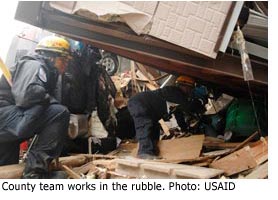 But the lessons learned on both missions are no laughing matter. And they hit close to home for members of the team because both New Zealand and Japan are affluent, highly-developed countries with many similarities to Southern California.
But the lessons learned on both missions are no laughing matter. And they hit close to home for members of the team because both New Zealand and Japan are affluent, highly-developed countries with many similarities to Southern California.
“We write off a lot of the lessons learned in underdeveloped countries,” such as Haiti, Ewald said, because of stark differences in building codes and other factors.
This time, “some of the takeaway was how these types of disasters would have impacted Los Angeles County.”
“Christchurch looks just like downtown Pasadena, or Long Beach,” he said. And as for the tsunami that devastated Japan: “Their only crime there was having exposure to a coastline, which we also have…How would we respond if that kind of widespread, catastrophic event had happened here?
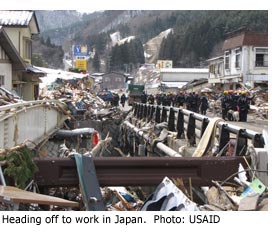 “The skills we learned there are directly transferable.”
“The skills we learned there are directly transferable.”
Ewald said both incidents point up the need to further hone disaster planning and preparedness in Los Angeles, and suggest that a “decentralized decision-making” process may be required in the event of a massive catastrophe like that experienced in Japan.
On a personal level, Ewald—who managed to grab the time to watch “American Idol” with his family between deployments—took advantage of some rare down time early in the week to drop out of sight, as far as work was concerned.
“I kind of kept myself below the radar,” he said. “My cup runneth over.”
California Task Force 2 returned home from Japan on Saturday, March 19. This YouTube video captures the homecoming, as does this CBS Channel 2 video. An array of still images showing the team’s work in Japan and New Zealand is on Facebook. And a National Public Radio report is here.
Posted 3/23/11
Colleges making the grade with bikes
March 24, 2011
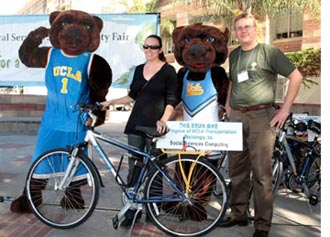 There may be no better way to keep off the dreaded “freshman fifteen” than by cycling to class, and that’s just one of the reasons that students and universities across the country are pushing hard to make their campuses more bike-friendly.
There may be no better way to keep off the dreaded “freshman fifteen” than by cycling to class, and that’s just one of the reasons that students and universities across the country are pushing hard to make their campuses more bike-friendly.
Westwood’s own UCLA is one of twenty schools nationwide that have earned a place on the inaugural “Bicycle Friendly Universities” list, recently announced by the League of American Bicyclists. Five other schools from California also earned the distinction, with Stanford University awarded the “Platinum” medal for being the most bicycle friendly university nationwide. Four of the schools on the list are part of the University of California system.
LAB is a Washington, D.C.-based group that has advocated for cyclists since their main roadway competition was the horse and buggy. Their first major effort was the Good Roads Movement of 1880, which spurred the creation of a system of paved roads that would be easier on cyclists than the existing bumpy, horse-pocked dirt roads. In doing so, they literally paved the way for the automobile. Through an ironic twist of historical fate, they now struggle against the horseless carriage for wiggle room on the very system of roads they helped to create.
LAB’s Bicycle Friendly University program represents an attempt to turn back the clock on our car-dominated culture for the sake of the future. The use of bicycles to combat gas-guzzling automobiles is gaining steam these days. L.A. County’s first Master Bike Plan in 36 years is now in the works, and the city of L.A. just approved its own plan.
LAB’s program looks at the design of the schools and surrounding community to see how bikes are physically accommodated with lanes, parking and signage. It also evaluates institutional offerings such as bike safety classes, programs and organizations that reward cycling, cooperation with law enforcement, and plans for the future.
UCLA achieved a bronze-level distinction in a city where people often accept traffic jams as an unavoidable part of daily life. Among the campus programs that helped the Bruins earn this achievement is the Bike Library, a program where students can rent a bike for the entire quarter for only $35. The program has been wildly successful, and UCLA plans to expand it in the fall. There also is an on-campus bike shop for quick minor repairs, and campus bike routes ease bike commuters in their travels.
Posted 3/24/11




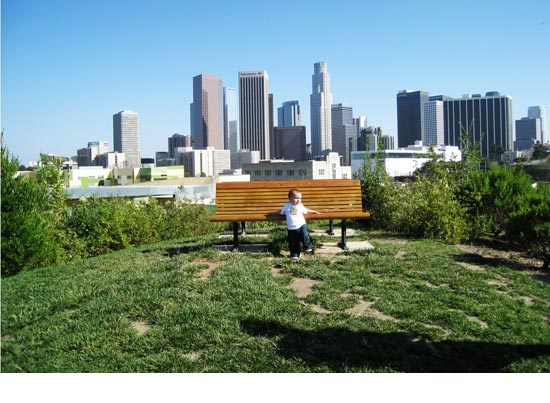
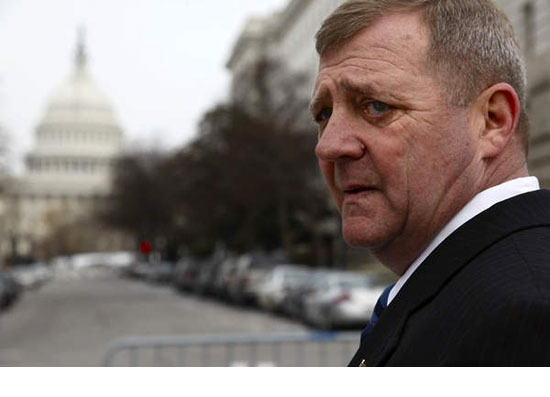
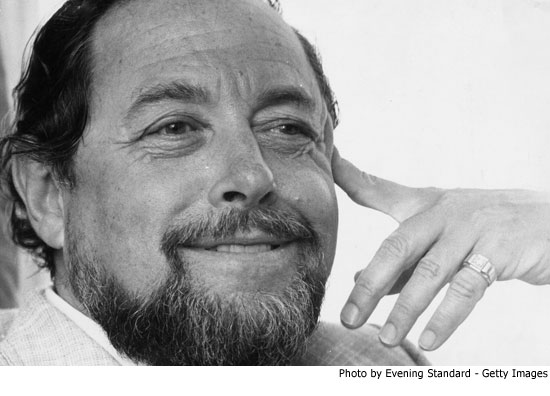
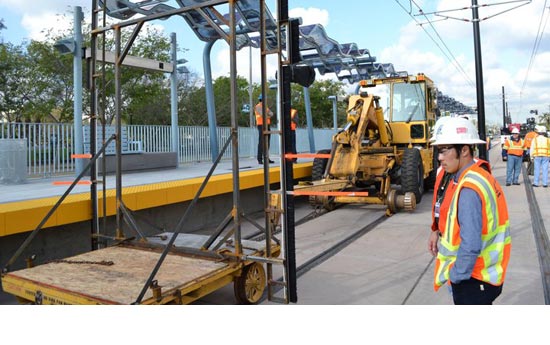
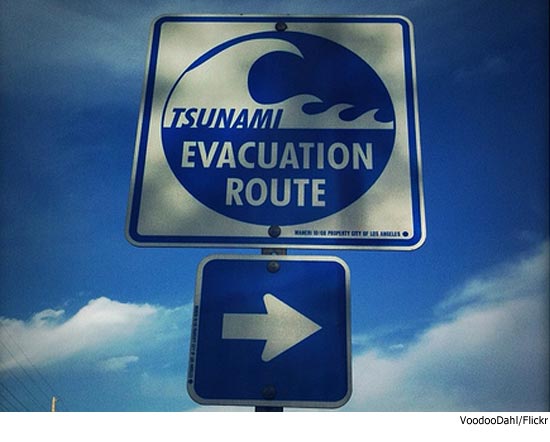
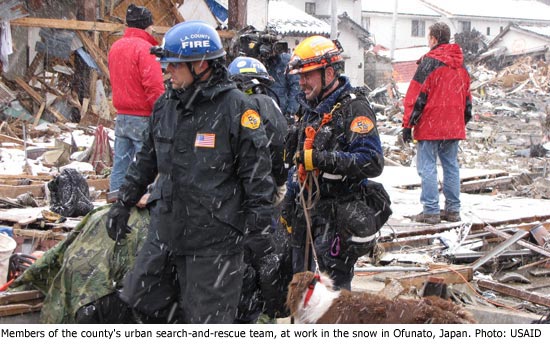
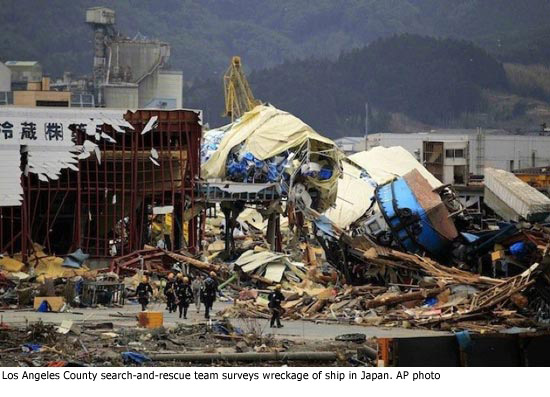





 Check for the latest closure information
Check for the latest closure information








